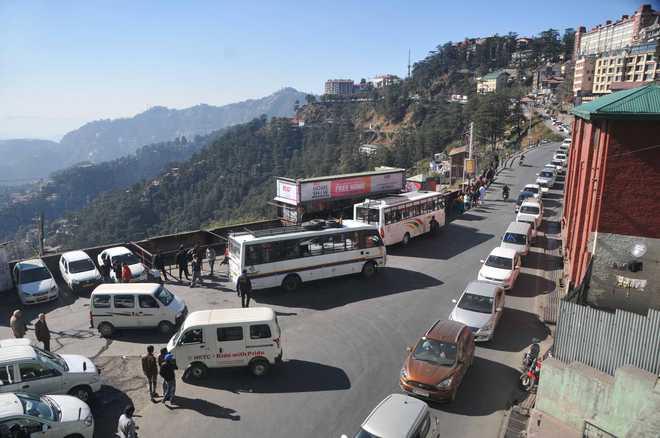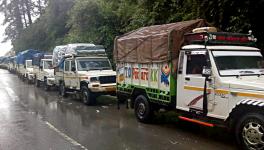Shimla Mobility Plan: Focus on Pedestrians, Not on Cars

Image for representational use only.Image Courtesy : The Tribune
It is disturbing to know that the mobility plan in Shimla has been inversed by the city and the state governments and placed on its head. What is painful is that even the Himachal Pradesh High Court, has succumbed to pressure from advocates and has opened some of the main restricted and sealed roads in hill town.
The road from Boileauganj to Vidhan Sabha and from Sanjaulli to IGMC has been opened up for motorised transport. This is a full-blown attack on the spirit of Shimla’s mobility, which is based on pedestrianisation.
Probably one of the highest pedestrianised small cities in India, Shimla has over 42% commuters who are pedestrians. This is slowly getting eroded, reminding one of author Mike Davis’s book on urban poverty, The Planet of Slums, wherein he talks about the middle class encroachment into spaces of the marginalised.
The affluent section of the population, who own cars and want wide roads, are prepared to even trample on the basic spirit of the town for their convenience. This is not a sustainable mode of mobility. This is evident by the daily traffic jams lasting several hours in a hilly town like Shimla.
Some of the ardent votaries of the opening up of these sealed and restricted roads in Shimla argue that it is a colonial legacy that we must get rid of it. There should be democratisation of spaces even on roads. Why should sealed roads be allowed to be used by only high-up officials, politicians, and judges, they say. While there is some merit in this argument, it is actually inverse. The demand should be to forbid even the above privileged sections from using these spaces, and that these roads should be used only for emergency purposes. There are a whole lot of people who walk on these roads as these are the only spaces that are the ‘urban commons’ for Shimla’s pedestrians.
Interestingly, giving a similar argument, a former chief justice of HP High Court, V K Gupta, passed an order that vehicles should be used on every road of Shimla town and even on the Ridge. He even called upon people to ply their vehicles on the Mall and the Ridge, arguing that the colonial legacy must end. The next day, it was only the aforesaid chief justice who took his vehicle to the Ridge, no citizen of the town took her vehicle to that point. Later, that order was annulled by the Supreme Court.
INTERVENTION OF THE COURT
Now, once again, the HP High Court is asking the civic authorities to work out a plan to ease traffic woes of Shimla town. Actually, the focus of the civic authorities, which includes the Shimla Municipal Corporation, district police, district administration etc., is more on enhancing parking facilities in the town, without realising that this will accentuate the problem, rather from resolve it. The idea should be to dissuade people from using private cars and use public transport, pool vehicles or simply walk in Shimla town.
SHIMLA COMPREHENSIVE MOBILITY PLAN
Unfortunately, the civic administration’s prepares plans and then dumps them. One such plan is the Shimla Comprehensive Mobility Plan (CMP). This plan was prepared by the Shimla Municipal Corporation in consultation with experts in the field of mobility. Later, it was adopted in the Shimla MC and was also approved by the state government.
This plan lays a 2015-31 period for the mobility in the town, with an overall investment of Rs 6,000 crore. Any intervention, either by the state government or even by the courts must lay its basis on this plan, on the preparation of which humongous amounts were spent under the JNNURM (Jawaharlal Nehru National Urban Renewal Mission. Mobility in Shimla should not be decided according to whims and fancies of an individual’s mobility.
The CMP is for a period of 16 years and takes into consideration the progressive growth of the population. It is an extensive document that speaks about overall development in the mobility sector in Shimla town. Some of the basic postulates of the CMP are:
-
Focus on pedestrian mobility: Unlike other towns and cities, Shimla has an advantage of being a highly pedestrianised town. The effort should be to further consolidate it and reinforce it with some positive decisions. It is interesting to note that only 25% houses in the Shimla town are connected with motorised roads and the efforts of the civic administration should not be to construct more roads as it increases the vulnerability of the mountain cities owing to landslides etc., and also induces people to buy more cars.
-
Vertical mobility: the initiative should be to enhance vertical mobility from Cart Road to Mall Road and several other places. For that, a number of escalators and elevators should be constructed. Since the mountain is cone shaped (on top lesser distance whereas the lower girth has a longer distance), from the Mall a little distance trudged on foot can many times increase the distance required to be covered along the Cart Road. Emphasis should be laid on vertical mobility, not on construction of new roads. There are just two elevators called the “Lift”; there is ample scope to increase the number from different interconnections to reduce the horizontal mobility of the people.
-
Restricting the entry of vehicles during peak time: It is explicitly mentioned in the CMP that the city must adopt the principle of coercing the vehicles entering during peak time with a progressive tax to dissuade people using private cars and promote use of public transport. A green fee on vehicles entering the city should be levied. The amount generated through this mechanism must be pumped back into green growth strategies of the town.
-
Public Transport: Simultaneously, public transport must be strengthened but there is no need to buy more buses. In fact, a fleet of 200 buses is sufficient to meet the requirements of public transport in the city.
-
More Tunnels: Construction of two tunnels connecting the Lift to Rivoli and on the other side, connecting to Chotta Shimla must be pursued immediately so that the entire loop of travel is minimised. Then, probably, the city can even opt for a one-way traffic. This shall also reduce the distance substantially. The first tunnel is estimated to be 1-km long and the second one around 750 metres. Both the tunnels are of walking distance and hence would bring much relief to commuters.

The above image is self-explanatory. It shows the proposed plan of development strategies for Shimla town as envisioned in the CMP.
Under the CMP, scenario 3 is what the Shimla town has to look up to. There are some short-term measures and a few that may take a longer term.
In case the civic administration falters and follows the whims and fancies of a few, then Shimla town is in for big trouble. The situation will be so unsustainable that the number of vehicles would see a meteoric rise from the present (2011 base year) 9% to 38%. With just 9%, it is extremely difficult to commute, imagine a jump to 38% situation!
IS THERE NO MONEY?
This is apparently not true for Shimla town. The Shimla MC has already approved a detailed project report (DPR) of Rs 1,000 crore, which was also approved by the HP state government and is now lying with the department of economic affairs (DEA), government of India, since the past two years. Probably this also speaks volumes about the efficiency of the Bharatiya Janata Party government at the Centre.
In case the DPR is approved by the DEA, money can be utilised from various heads. The smart city project is one source, as also there are many financial agencies willing to fund the town. Hence, money is not, and should not be a problem for Shimla city to get rid of its mobility woes.
What is disturbing is the complete disregard for the basic spirit of planning of the city and adopting knee-jerk methods to mitigate the traffic crisis. This will not work, for sure.
The writer is former Deputy Mayor of Shimla, Himachal Pradesh. The views are personal.
Get the latest reports & analysis with people's perspective on Protests, movements & deep analytical videos, discussions of the current affairs in your Telegram app. Subscribe to NewsClick's Telegram channel & get Real-Time updates on stories, as they get published on our website.















